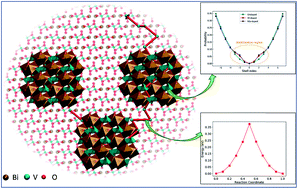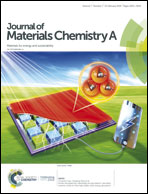Charge carrier transport dynamics in W/Mo-doped BiVO4: first principles-based mesoscale characterization†
Abstract
We present mesoscale characterization of carrier transport in W/Mo-doped ms-BiVO4 (BVO) to supplement our earlier study of electron and hole transport in bulk BVO. The mesoscale kinetic Monte Carlo (KMC) approach, supported by first principles-determined electron and hole hopping rates, captures the complex dynamics of electron carriers arising from light absorption and from metal doping. The computations and simulations support the observation that, for the doping level used in experiment, doping atoms do not affect significantly the transport dynamics of the charge carriers compared to stoichiometric BVO. W/Mo doping increases the electron carrier concentration and consequently the electrode conductivity. We used a density functional theory DFT + U method to characterize the electronic structure of doped BVO. Each W and Mo atom brings one more valence electron than a V atom. These excess electrons are mobile. We adopted the theories and methods of our earlier investigations on BVO. The DFT + U theory affords an accurate description of small electron polarons with electrons localized on W or Mo or V, as well as of the hopping barriers from W/Mo-to-V or V-to-V. Calculations on a 3 × 3 × 1 supercell of W/Mo-doped ms-BVO indicate that the excess electron from W or Mo does not reside on the doping atom. There is a shallow interaction region around the doping atom where the excess electron localized on a V atom is more stable than when localized on the doping atom and slightly more stable than when the excess electron is localized far away from the doping atom. This region is two nearest V atom-wide for W and three nearest atom-wide for Mo. The depths of these stabilization regions are very small, ∼−0.65 kBT (at 300 K) for W and ∼−0.73 kBT for Mo. Calculated V-to-V hopping barriers in the doped material are little affected within the region and not affected outside the region. Using our recently developed lattice-based kinetic Monte Carlo code adapted to account for doping atoms and their energy stabilization regions, we calculated the diffusivity of electrons for carrier density relevant to experiment as well as the conductivity. The stabilization regions have little effect on the diffusivity compared to the stoichiometric system because of the smallness of the stabilization. The diffusivity is found to decrease slightly with an increasing number of carriers, but the conductivity of a system with electron polarons arising from doping together with light absorption increases compared to that of the un-doped system. This work will set the foundation to study electron transport in gradient (W/Mo)-doped systems and other mixed phase systems.



 Please wait while we load your content...
Please wait while we load your content...